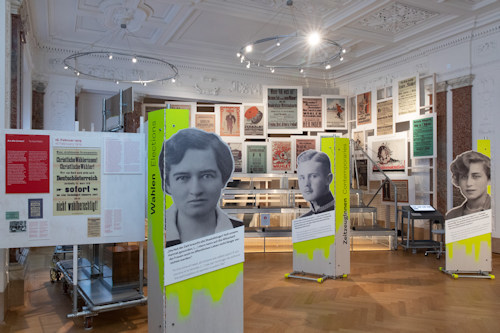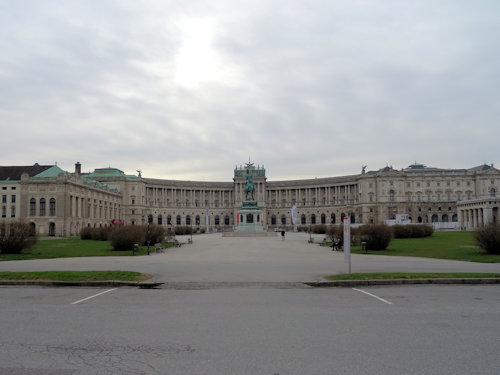As one of Vienna’s newest museums, Das Haus der Geschichte Österreich (The House of Austrian History) takes a critical, balanced look at the country’s recent heritage and what it means to be Austrian.
- Covers contemporary Austrian history
- Main exhibition tackles post-WWI development
- Modern, detailed displays
- Also hosts special exhibitions
- All information available in English, too
- Entrance ticket lets you visit the Ephesos Museum
- Join a guided WWII walking tour* of Vienna
- See also:
The museum

(View of the new main exhibition; press photo credit: eSeL.at – Lorenz Seidler)
Austria’s past is not all palaces and polkas. In the last 100 years, for example, we witnessed the birth, death and rebirth of democracy, as well as one of the darkest chapters in world history.
The House of Austrian History’s main New Ages: Austria since 1918 exhibition takes you on an intense journey through those ten decades. The highs were rather high. The lows rather unimaginably low.
Democracy, Nazi terror, equality, migration, and the meaning of nationality are just some of the themes tackled. (Told you it was intense).
The modern displays offer insights into the key moments of all that history, supported by multimedia elements, numerous items of “memorabilia”, and personal stories from those involved in the events covered.
The museum celebrates the positive developments, but does not shy away from highlighting those darker times.
And for non-Austrians, the most interesting parts are, inevitably, those covering the immediate aftermath of WWI and the period of Nazi rule.
Post-WWI

(Soldiers arrive back at Vienna’s Südbahnhof station after the war, 1918-1919; photographed by Richard Hauffe; Wien Museum Inv.-Nr. 49342/83; excerpt reproduced with permission under the terms of the CC0 licence)
What few of us perhaps realise is that within the space of about 24 hours at the end of 1918, Austria went from a powerful empire led by a centuries-old imperial dynasty to a defeated tiny democracy low on cash and self-esteem.
The exhibition presents contrasting domestic reactions to defeat and the end of the monarchy, then examines the chaos and harsh reality of the aftermath.
This aftermath includes the socioeconomic changes brought on by economic devastation. Take inflation, for example. As a display explains, 10,000 crowns bought you an apartment before the war and about one kilo of sugar in 1924.
Beginning in 1918, the country undertook a radical transformation across all spheres of life – from politics to street names – as democracy replaced authoritarian rule.
Fascism and Nazi rule
I actually cried on first seeing the displays on the growth of home-bred Austro-fascism in the 1930s and the impact of Anschluss with Nazi Germany in 1938.
Tears at the utter insanity of that short period where reason and humanity seemed to desert so many people (but not all, fortunately).
Tears at the banality of the forms taken by such extremism, like the (badly drawn) Nazi symbols in an exercise book belonging to a primary school pupil.
Tears at the initial political reluctance to accept Austrian complicity in Nazi terror.
Tears at the organised killing. Not just those so familiar, like in the concentration camps, but also through, for example, the Hartheim Castle euthanasia centre.
Tears at the complicity of the local population.
Tears at the stories of those who resisted and gave their lives as a result.
And tears at the 1945 poster from Vienna, urging women and children to leave the city before the Russians arrived and the “last battle” commenced. Someone had scribbled across the bottom: “where to?” Quite.
(I still tear up at the exhibits, but mostly at the stories.)

(The Neue Burg houses the museum)
The rest
Elsewhere you emerge (much like Austria) into a more upbeat future. And the timeline ends with two notable exhibits:
- The dress worn by Conchita Wurst when she won the 2014 Eurovision Song Contest for Austria
- The USB stick that contained the “Ibiza” video footage that brought down the Austrian government in 2019
Tickets & visitor tips
At the time of writing, a ticket also gets you into the Ephesos Museum, a small collection of Greek and Roman antiquities that’s part of the Kunsthistorisches Museum group.
Both museums occupy part of the Neue Burg tract of the Hofburg Palace complex, so you might like to visit just to see inside this rather magnificent building.
The two institutions make strange bedfellows. One a gentle walk among marbled columns and the remains of an ancient civilisation, the other a roller coaster ride through the trials and triumphs of a young democracy.
Vienna: a city of contrast and paradox!
The House of Austrian History also hosts special exhibitions in, for example, the Alma Rosé Plateau. This large hall sits directly behind the (in)famous Neue Burg terrace, where Hitler once addressed the crowds.
Some other museums and institutions in Vienna have a strong history element. For example:
- Visit the Austrian parliament for more background on Austria’s political evolution (guided tours available in English)
- Visit the Jewish Museum for more on the city’s Jewish history
- Visit the Wien Museum for three floors covering Vienna’s own history, including several sections addressing the period from post-WWI to the current day
How to get to the museum
The museum will be moving to the MuseumsQuartier in 2028. But, for now, it remains in the Neue Burg wing of the central Hofburg complex that dominates the main tourist routes in Vienna’s old town.
The entrance to the Ephesos Museum and House of Austrian History is at the centre of the building on the side facing Heldenplatz square. You can’t miss it, since it screams “Imperial entrance” at you, with its steps and ornate gates.
Subway: Your best bet is Volkstheater (on the U2 and U3 lines) or Museumsquartier (on the U2)
Tram/bus: Take any of the ring trams to Burgring: 1, 2, D, 71
For a bit of green relief from monumental buildings and concrete footways, nip behind the museum to visit the Burggarten park. Or walk away from the front entrance to eventually reach the Volksgarten with its glorious rose gardens.
Address: Heldenplatz, 1010 Vienna | Website
